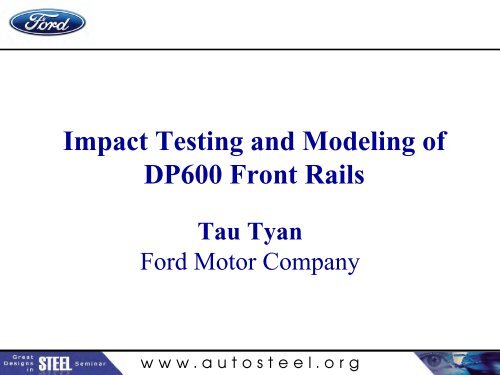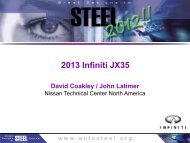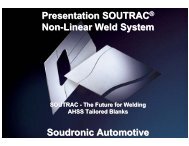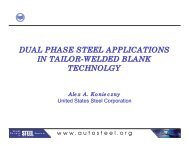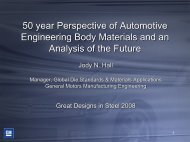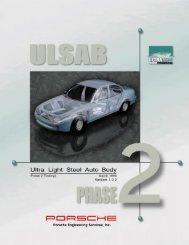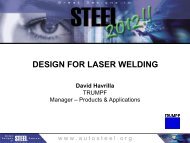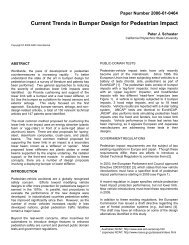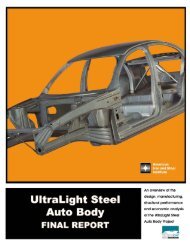Impact Testing and Modeling of DP600 Front Rails Tau Tyan
Impact Testing and Modeling of DP600 Front Rails Tau Tyan
Impact Testing and Modeling of DP600 Front Rails Tau Tyan
You also want an ePaper? Increase the reach of your titles
YUMPU automatically turns print PDFs into web optimized ePapers that Google loves.
<strong>Impact</strong> <strong>Testing</strong> <strong>and</strong> <strong>Modeling</strong> <strong>of</strong><br />
<strong>DP600</strong> <strong>Front</strong> <strong>Rails</strong><br />
<strong>Tau</strong> <strong>Tyan</strong><br />
Ford Motor Company<br />
w w w . a u t o s t e e l . o r g
Automotive Center<br />
US Steel<br />
• Gu<strong>of</strong>ei Chen<br />
• Ming Chen<br />
• Ming Shi<br />
w w w . a u t o s t e e l . o r g<br />
Contribution<br />
NAE Truck Safety<br />
Ford Motor Company<br />
• Meagan Gonzalez<br />
• Karthik Chitoor<br />
• Heung-Soo Kim<br />
• Yijung Chen<br />
• Miinshiou Huang<br />
• Matt Maltarich<br />
• Timothy Bailey<br />
• Dennis Heinanen
w w w . a u t o s t e e l . o r g<br />
Outline<br />
• Introduction – Generic Cross-section<br />
• <strong>DP600</strong> Multicorner Columns in Axial Crush<br />
• <strong>DP600</strong> Multicorner Columns in Side Bending<br />
• <strong>DP600</strong> 12 Corner Columns in Full Vehicle<br />
<strong>Front</strong>al <strong>Impact</strong> Application<br />
• Conclusions
•SUV/Truck Frame<br />
• CAE <strong>Modeling</strong><br />
• <strong>DP600</strong><br />
•Weight Optimization<br />
•Geometry<br />
• Material<br />
• Thickness<br />
• Cross-section<br />
w w w . a u t o s t e e l . o r g<br />
Introduction
Generic Cross-section Comparison<br />
w w w . a u t o s t e e l . o r g
Dynamic Crush Mode Comparison<br />
w w w . a u t o s t e e l . o r g
w w w . a u t o s t e e l . o r g<br />
Outline<br />
• Introduction – Generic Cross-section<br />
• <strong>DP600</strong> Multicorner Columns in Axial Crush<br />
• <strong>DP600</strong> Multicorner Columns in Side Bending<br />
• <strong>DP600</strong> 12 Corner Columns in Full Vehicle<br />
Application<br />
• Conclusions
<strong>DP600</strong> Multicorner Columns in Axial Crush<br />
<strong>DP600</strong> (a) Hexagonal <strong>and</strong> (b) Octagonal rails <strong>of</strong> thickness 1.5mm.<br />
(a) 56 mm (2.205”) 120 º 56 mm (2.205”)<br />
(b)<br />
Outer<br />
28 mm (1.102”)<br />
Apply wel ds<br />
along the edge<br />
120 º for all angles<br />
120 º<br />
All dimensions are measured between outside surfaces<br />
120 º<br />
54.3 mm (2.138”)<br />
120 º<br />
97.0 mm (3.819”)<br />
112.9 mm (4.445”)<br />
Inner<br />
54.3 mm (2.138”)<br />
28 mm (1.102”)<br />
36 mm (1.417”)<br />
28 mm (1.102”)<br />
Apply welds<br />
along the edge<br />
t(mm) YS(MPa) TS(MPa) n El(%)<br />
1.5 392 696 0.868 13.6<br />
Mechanical properties <strong>of</strong> <strong>DP600</strong><br />
Strain rate data<br />
for <strong>DP600</strong>.<br />
21 mm (0.827”)<br />
Apply welds<br />
along the edge<br />
1200.0<br />
1000.0<br />
800.0<br />
600.0<br />
400.0<br />
200.0<br />
w w w . a u t o s t e e l . o r g<br />
True stress in MPa<br />
0.0<br />
Outer<br />
42 mm (1.653”)<br />
All dimensions are measured between outside surfaces<br />
29 mm (1.142”)<br />
135º<br />
42 mm (1.653”)<br />
135º<br />
21 mm (0.827”)<br />
40.8 mm (1.606”) 40.8 mm (1.606”)<br />
135º<br />
135º<br />
40.8 mm (1.606”)<br />
102.9 mm (4.051”)<br />
102.0 mm (4.016”)<br />
Inner<br />
29 mm (1.142”)<br />
42 mm (1.653”)<br />
<strong>DP600</strong>-Material curves - plastic portion<br />
Apply welds<br />
along the edge<br />
21 mm (0.827”)<br />
0.005 0.1 10 100 500 SHB1000<br />
0.0000 0.0500 0.1000 0.1500 0.2000 0.2500<br />
True strain
Axial Crush Test Setup<br />
Speed Machine Attached mass<br />
1 in/min Tinius Olsen N/A<br />
15 mph VIA Sled 2999 lbs<br />
30 mph VIA Sled 548 lbs<br />
Quasi-static test setup Dynamic test setup<br />
w w w . a u t o s t e e l . o r g
w w w . a u t o s t e e l . o r g<br />
CAE Methodology<br />
The following effects are included in the model:<br />
• Dimensions <strong>and</strong> thickness were measured from actual parts<br />
(sample size = 3)<br />
• Material properties were taken from coupon tests <strong>and</strong> input<br />
using Radioss type 36 material law<br />
• Forming <strong>and</strong> welding effects are considered in the model<br />
• Strain rate effect is also included in the model with tabulated<br />
material law
• Hexagonal Quasi-static Axial Crush<br />
CAE & Test Comparison<br />
w w w . a u t o s t e e l . o r g
• Octagonal Quasi-static Axial Crush<br />
CAE & Test Comparison<br />
w w w . a u t o s t e e l . o r g
• Hexagonal 15mph Axial Crush<br />
CAE & Test Comparison<br />
w w w . a u t o s t e e l . o r g
• Octagonal 15mph Axial Crush<br />
CAE & Test Comparison<br />
w w w . a u t o s t e e l . o r g
• Hexagonal 30mph Axial Crush<br />
CAE & Test Comparison<br />
w w w . a u t o s t e e l . o r g
• Octagonal 30mph Axial Crush<br />
CAE & Test Comparison<br />
w w w . a u t o s t e e l . o r g
1 Element<br />
formulation<br />
Sensitivity Study <strong>of</strong> Axial Crush Parameters<br />
Variable Value<br />
2 Friction coefficient<br />
3 Mesh size<br />
4 Strain rate<br />
5 Corner/weld<br />
properties<br />
6 Gage<br />
7 Initial velocity<br />
8 Shape change<br />
9 Tilt angle<br />
Effect on peak<br />
force<br />
15mph 30mph<br />
Effect on crush<br />
distance<br />
w w w . a u t o s t e e l . o r g<br />
Effect on peak<br />
force<br />
Effect on crush<br />
distance<br />
Belytschko-Tsay element - - - -<br />
QEPH element decrease increase decrease increase<br />
QPPS element increase decrease increase decrease<br />
0.3 - - - -<br />
0.1 none none none increase<br />
5.0mm - - - -<br />
2.5mm none increase increase decrease<br />
Strain rate properties - - - -<br />
No strain rate properties decrease increase decrease increase<br />
Corner + weld properties - - - -<br />
Weld properties only none none none increase<br />
Forming properties only none none none increase<br />
No forming/weld properties none none increase increase<br />
1.5mm - - - -<br />
1.65mm increase decrease increase decrease<br />
1.35mm decrease increase decrease increase<br />
15mph - - - -<br />
14mph none decrease none none<br />
16mph none increase none increase<br />
nominal - - - -<br />
oblong none none decrease increase<br />
0 degrees - - - -<br />
0.1 degrees none none none decrease<br />
0.2 degrees none increase none decrease
w w w . a u t o s t e e l . o r g<br />
Outline<br />
• Introduction – Generic Cross-section<br />
• <strong>DP600</strong> Multicorner Columns in Axial Crush<br />
• <strong>DP600</strong> Multicorner Columns in Side Bending<br />
• <strong>DP600</strong> 12 Corner Columns in Full Vehicle<br />
<strong>Front</strong>al <strong>Impact</strong> Application<br />
• Conclusions
Striker 2" o.d..<br />
560 mm<br />
700 mm<br />
1in/min<br />
Lateral Bending Test Setup<br />
3/8” thickness<br />
Crush<br />
Type<br />
Hexagonal <strong>and</strong> Octagonal quasi-static <strong>and</strong> dynamic bending test fixture<br />
w w w . a u t o s t e e l . o r g<br />
Machine Speed<br />
Attached<br />
Mass<br />
Quasistatic Tinius Olsen 1 in/ min N/A<br />
Dynamic Bendix 30 mph 77 lbs
CAE <strong>and</strong> Test Crush Mode Comparison<br />
Hexagonal & Octagonal 30mph lateral bending<br />
w w w . a u t o s t e e l . o r g
CAE <strong>and</strong> Test Comparison<br />
Hexagonal <strong>and</strong> Octagonal quasistatic bending<br />
Hexagonal <strong>and</strong> Octagonal 30mph lateral bending<br />
w w w . a u t o s t e e l . o r g
w w w . a u t o s t e e l . o r g<br />
Energy Comparison<br />
Hexagonal <strong>and</strong> Octagonal quasistatic bending Hexagonal <strong>and</strong> Octagonal dynamic bending
Variable Value Effect on Peak Force<br />
Element Formulation<br />
Friction Coefficient<br />
Mesh Size<br />
Strain Rate<br />
Forming / Weld Properties<br />
Gage<br />
Initial Velocity<br />
Sensitivity Study <strong>of</strong> Axial Crush Parameters<br />
Belytschko-Tsay Element -<br />
QEPH Element Increase<br />
QPPS Element Increase<br />
0.3 None<br />
0.1 -<br />
5.0 mm -<br />
2.5 mm Increase<br />
Strain Rate Properties -<br />
No Strain Rate Properties Decrease<br />
Forming + Weld Properties -<br />
No Weld Properties None<br />
No Forming Properties Decrease<br />
No forming / Weld Properties Decrease<br />
1.5 mm -<br />
1.65 mm Increase<br />
1.35 mm Decrease<br />
30 mph -<br />
29 mph None<br />
31 mph None<br />
w w w . a u t o s t e e l . o r g
w w w . a u t o s t e e l . o r g<br />
Outline<br />
• Introduction – Generic Cross-section<br />
• <strong>DP600</strong> Multicorner Columns in Axial Crush<br />
• <strong>DP600</strong> Multicorner Columns in Side Bending<br />
• <strong>DP600</strong> 12 Corner Columns in Full Vehicle<br />
<strong>Front</strong>al <strong>Impact</strong> Application<br />
• Conclusions
C1<br />
Cross-section<br />
C0<br />
Cross-section<br />
C2<br />
Cross-section<br />
w w w . a u t o s t e e l . o r g<br />
Tapered Cross-sections
C1<br />
Cross-section<br />
Tapered Cross-sections with Convolutions<br />
C0<br />
Cross-section<br />
C2<br />
Cross-section<br />
w w w . a u t o s t e e l . o r g
Sensitivity Analyses (Tapered Crosssections<br />
with Convolutions - C1)<br />
Best-fit (2.3mm)<br />
Baseline<br />
w w w . a u t o s t e e l . o r g<br />
C1<br />
DOE Setup<br />
Material - <strong>DP600</strong><br />
Gage=3.3 ~ 2.1 mm<br />
Best-Fit<br />
C1 –<strong>DP600</strong>–2.3mm<br />
Weight x2 = 18.87 lb<br />
Saving = 8.25 lb<br />
(30.42%)
Best-fit (2.3mm)<br />
Sensitivity Analyses (Tapered Crosssections<br />
with Convolutions- C2)<br />
Baseline<br />
w w w . a u t o s t e e l . o r g<br />
C2<br />
DOE Setup<br />
Material – P415 AP1<br />
Gage=3.3 ~ 2.1 mm<br />
Best-Fit<br />
C2 –AP1_mat–2.3mm<br />
Weight x2 = 18.21 lb<br />
Saving = 8.91 lb<br />
(32.86%)
<strong>Front</strong> Rail Design<br />
Material<br />
32Ksi<br />
<strong>DP600</strong><br />
Tapered Cross Section<br />
Without Convolution<br />
w w w . a u t o s t e e l . o r g<br />
Tapered Cross Section<br />
With Convolution<br />
C0 C1 C2 C0 C1 C2<br />
Gage (mm) 3.30 2.70 2.10 3.30 2.70 2.30<br />
Weight (lb) 24.95 20.69 16.06 27.12 21.69 18.21<br />
Saving<br />
(lb) 0.00 4.26 8.89 0.00 5.43 8.91<br />
(%) 0.00 17.09 35.64 0.00 20.01 32.86<br />
Gage (mm) 2.90 2.30 1.70 2.70 2.30 2.00<br />
Weight (lb) 21.91 19.18 13.01 22.18 18.87 15.83<br />
Saving<br />
Component Performance Comparison<br />
(lb) 3.04 5.77 11.94 4.94 8.25 11.29<br />
(%) 12.18 23.13 47.87 18.22 30.42 41.64
Full Vehicle Crash Application<br />
Baseline 12-Corner<br />
w w w . a u t o s t e e l . o r g
Baseline<br />
12-Corner<br />
NCAP Performance Comparison<br />
w w w . a u t o s t e e l . o r g
Baseline<br />
12-Corner<br />
NCAP Deformation Comparison<br />
w w w . a u t o s t e e l . o r g
Baseline<br />
12-Corner<br />
IIHS Offset Performance Comparison<br />
w w w . a u t o s t e e l . o r g
IIHS Offset Intrusion Comparison<br />
w w w . a u t o s t e e l . o r g
w w w . a u t o s t e e l . o r g<br />
Outline<br />
• Introduction – Generic Cross-section<br />
• <strong>DP600</strong> Multicorner Columns in Axial Crush<br />
• <strong>DP600</strong> Multicorner Columns in Side Bending<br />
• <strong>DP600</strong> 12 Corner Columns in Full Vehicle<br />
<strong>Front</strong>al <strong>Impact</strong> Application<br />
• Conclusions
w w w . a u t o s t e e l . o r g<br />
Conclusions<br />
• Geometry, material properties, forming effect, welding<br />
effect, strain rate, <strong>and</strong> other boundary conditions all<br />
contribute to model correlation <strong>and</strong> prediction.<br />
• The octagon has a small advantage over hexagon with<br />
respect to energy absorption in axial crush <strong>and</strong> lateral<br />
bending.<br />
• The 12 corner cross section presents more advantage over<br />
the other sections studied.<br />
• The 12 corner cross section saves weight <strong>and</strong> performs<br />
slightly better than the baseline design in front impact crash<br />
performances.


